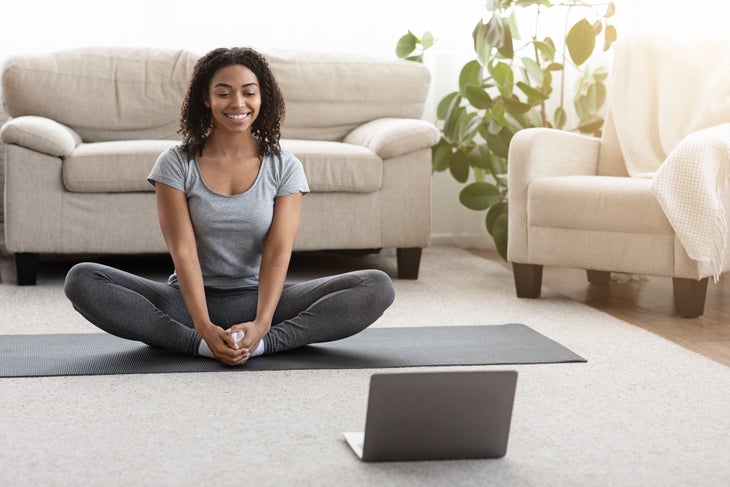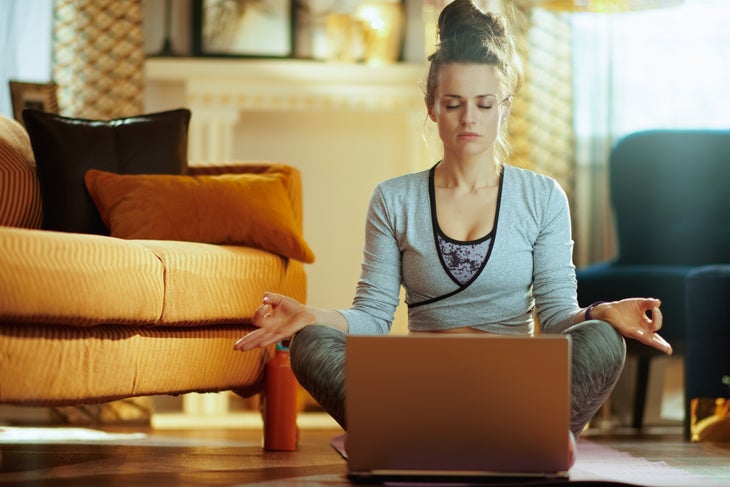Heading out the door? Read this article on the new Outside+ app available now on iOS devices for members! Download the app.
I first tried yoga in 2006, in a studio in the East Village in New York City. It was awkward. I didn’t know Down Dog from Up Dog and frustratedly mimicked my way through class. But during Savasana, with the sound of collective breathing reverberating in the room, something shifted. Bathed in the communal energy of my fellow students, I felt lifted by an otherworldly calm. I was hooked.

The power of this shared experience is what keeps a lot of us coming back to our mats again and again. It’s also something, in the wake of COVID-19, that many of us miss. Here, Yoga Journal takes a good look at what we’ve lost and what we’ve gained—in terms of energetic connection and community—with the current shift toward virtual yoga experiences.
The Benefits of Social Connection
There’s no shortage of studies that show how social connection helps us live longer and battle diseases. One landmark study posits that loneliness can be as deadly as obesity and smoking. It’s also no secret that many people discover a yoga practice to address emotional wounds, and that the social connection of a studio can be deeply healing.
Emma Seppälä, PhD, is the science director of Stanford University’s Center for Compassion and Altruism Research and Education, and co-director of the Yale College Emotional Intelligence Project at the Yale Center for Emotional Intelligence. “People who feel more connected to others have lower rates of anxiety and depression,” she says. “Moreover, studies show they also have higher self-esteem, are more empathetic to others, more trusting and cooperative and, as a consequence, others are more open to trusting and cooperating with them.”
But the mental health benefits of being in the community aren’t limited to in-person experiences. “A sense of connection is internal,” says Seppälä. “Researchers agree that the benefits of connection are actually linked to your subjective sense of connection. In other words, if you feel connected on the inside, she says, you reap the same benefits, regardless of whether that is in a yoga studio or in a Zoom class.
Further, she says, “yoga puts you in a parasympathetic mode. It alleviates stress. As such, you can naturally feel a greater sense of belonging, compassion, and connection. As you feel better, your sense of belonging also increases.”
The fact that virtual connection begets the same biological response as the in-person connection could be due to the presence of “mirror neurons” in our brains. According to a Scientific American piece written by a professor of Psychiatry and Biobehavioral Sciences at UCLA Marco Iacoboni, MD PhD, mirror neurons are what allow us to “feel” what another person experiences. We wince, for example, when someone else stubs their toe. We subconsciously smile when someone smiles at us.
Marketing strategist and author David Meerman Scott suggests that mirror neurons are to thank for the ability to connect with something we see on screen. “This helps to explain why we feel that we ‘know’ movie stars and television personalities,” he writes in his blog. “Our brain tells us that we’ve been in their personal space because of the feeling of proximity to them as we are seeing them up on the screen.”
“While I do miss the eye-to-eye contact or the human hug, I can still feel the energetic shift when teaching in my square,” says Katy Hanlon, who teaches live, two-way streaming classes on Livekick. Though Hanlon admits it was a little awkward at first—not unlike my first-ever class—she says it’s been surprising just how well energy transfers through the screen. “I believe in the power of creativity and innovation and technology,” she says, “that by showing up for ourselves we can show up for the greater collective.”
Judy Weaver, a trauma-informed teacher, and co-founder of Connected Warriors has experienced this first-hand as well. “Due to the depth and breadth of my therapy practice and years of teaching, I surprisingly found that I can really see energy online, and I am able to respond with the appropriate teaching for the student’s benefit,” she says. For Weaver, this means tailoring her classes for students that show up, just as she would in person.
Author, psychiatrist, and psychotherapist Bernard Beitman studies energy exchange between people. Beitman says that he experiences this shared “psychosphere” often with his patients. This is because we all emit bioelectric brain and body energy during social interaction. “I call it the engagement,” he says, “a literal engagement of energy fields.” He has personally experienced this in a virtual dance class when he made eye contact with a fellow student and felt a pop of energy similar to that which he feels with his patients. A virtual yoga class, he says, could absolutely be considered a mini-psychosphere—if practitioners are attuned to it.
see also How to Build a Home Practice

Better Accessibility
Ebony Smith founded Yoga N Da Hood as a way to bring yoga to underserved communities in Texas after being greeted for her first yoga class by a white woman who implied that she may be in the wrong place. While the organization has flourished since she started it in 2016, it’s exploded in the past few months, since she switched to a virtual model.
“It’s always been one of my dreams to have a brick-and-mortar studio, but definitely not now,” says Ebony. Pre-COVID, she was driving several hours a day between three different schools to serve 200 kids. Now, she says, she’s able to reach 500 in a day—all without the time, money, and stress of driving all over the city.
In addition to reaching more kids, Smith also has more adult students in her virtual public classes than she did in-person. She suspects that the increase is in part because people who previously shied away from trying yoga feel comfortable doing so for the first time at home, where stakes feel less high. Classes are donation-based, so the more students she reaches, the better off she does.
For people in marginalized communities, accessing virtual yoga can mean subverting the norm of being in a space that doesn’t reflect them. “The space on the Internet is a space created for everybody,” says Smith. In an industry that’s long been plagued with inaccessibility, the shift to virtual helps to level the playing field.
See also Ebony Smith’s Yoga Story
Yoga teacher Rina Jakubowicz brings up an entirely different point: virtual classes allow us to choose instructors who don’t teach in our city, styles that aren’t available in our town, and classes at times that are convenient for busy schedules. Midnight yoga after the kids go to sleep? No problem! In turn, says Jakubowicz, this encourages self-care.
DJ and yoga teacher Selena Isles, also known as DJ Seriousblack, agrees that a bonus of virtual yoga is the scheduling flexibility. She DJ’ed classes Hanlon taught on Livekick and had far-flung friends who were finally able to come to her class because they’re online. “In a way, [virtual yoga] has given thousands of students their practice,” says Isles. She also sees virtual yoga as a way to remove some of the distractions of studio classes, like comparing your posture to the student’s next to you, or other superficialities. When we strip away these distractions, Isles says, we’re left with our breath, our body, and our mat.
As the yoga community recalibrates, we’ll undoubtedly see a return to studio yoga in some capacity. Perhaps we’ll even see the return of large-scale yoga festivals and events in 2021. But virtual yoga seems here to stay—and that may not have as many negative consequences as we first thought.